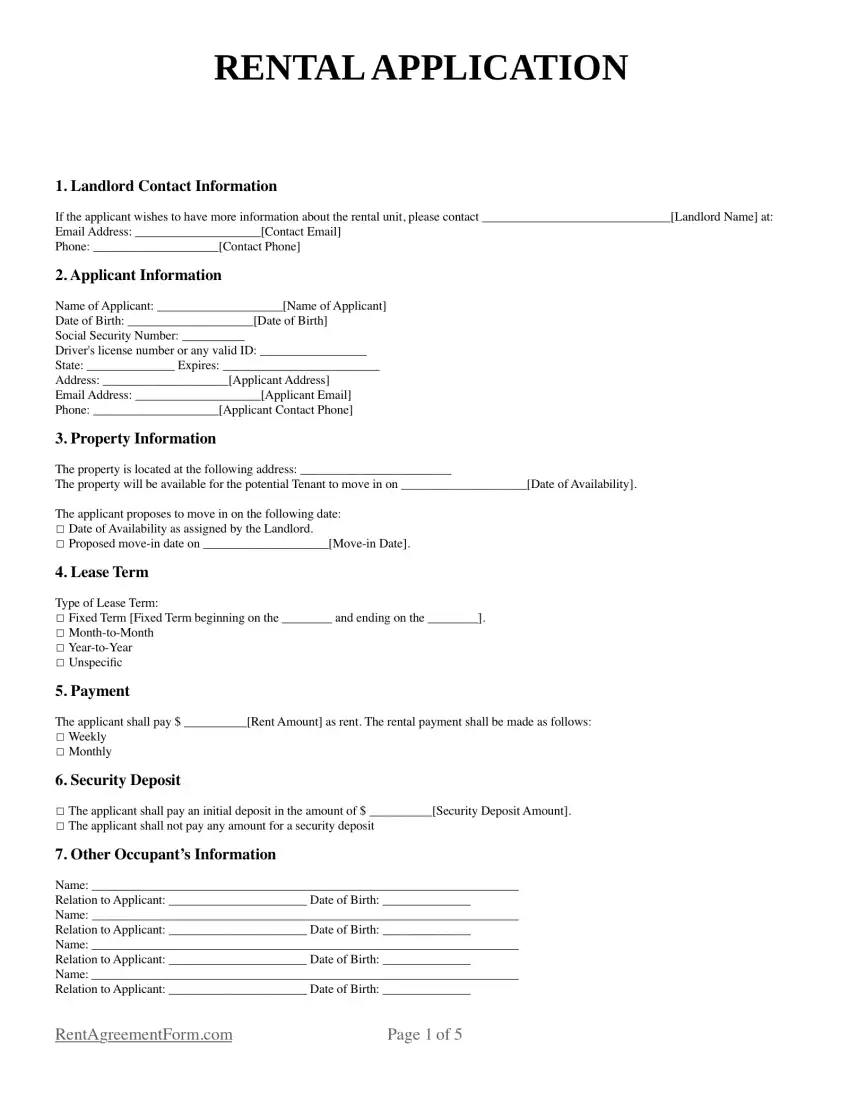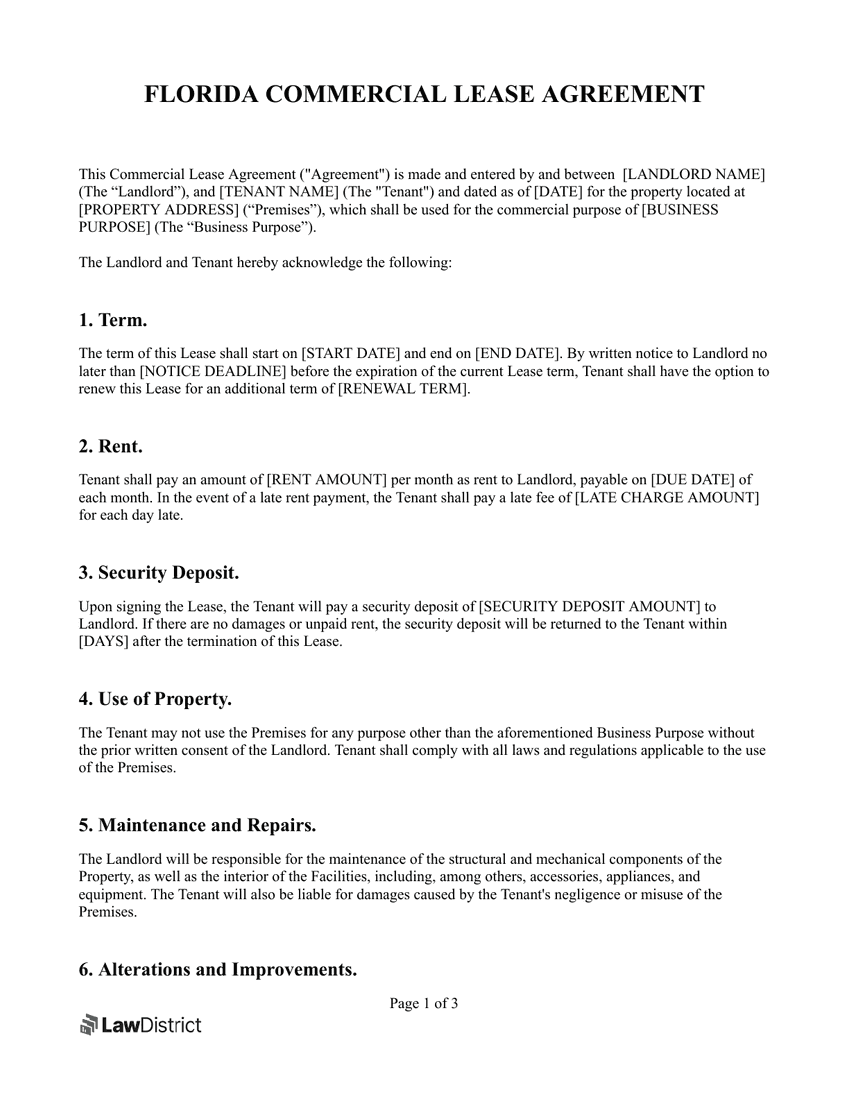Rental Agreement Forms
Even if you are renting to friends or family members, disputes sometimes can arise between both parties. A rent agreement form can minimize the chance of any conflicts by having a written, signed contract.
This page provides an overview of this valuable legal protection, including a look at the lease agreement forms by state and how the leasing process works.
![Rental Application Sample]() Rental Application
Rental ApplicationFinding a suitable apartment or rental home can take a lot of time and effort. You first scour online listings, then visit the places that meet your criteria in person. When you find the right one, it’s a huge relief. However, there is another process to go through before you can move into your new home.
This page provides an overview of the rental application process, including the answers to some of the most frequently asked questions.
![rla-florida-commercial-lease-agreement-sample]() Commercial Lease
Commercial LeaseIt’s important to use a Commercial Lease Agreement whenever you want to rent out a commercial property in the United States. This document details the financial aspects of the lease, and can act as a legal record if disputes arise in the future. It also sets expectations for both the landlord and the tenant.
Read on to learn more about the Commercial Leasing process and get the answers to some of the most commonly asked questions.
What is a Standard Residential Lease Agreement?
A standard residential lease agreement is a contract between a landlord and a tenant for the rental of residential property. The document covers a fixed term, typically one year. It can be used for any livable property, including single-family homes, apartments, condominiums, mobile homes, and room rentals.
After having their rental application approved, this agreement will be drawn up. After both parties sign the agreement, they are bound by its terms until the end of the rental period. The tenant then must pay the first month's rent and any required deposits after signing this legal document.
A standard residential lease agreement should contain the following components:
- Term of the lease: Start and end dates
- Rent: The amount and when it is due
- Deposits: The amount, what it covers, and details of how it will be returned
- Contact information of the landlord or management company
- Utilities that are covered by the rent (if any)
- Building and property rules
Lease Agreement Forms by State
- Alabama
- Alaska
- Arizona
- Arkansas
- California
- Colorado
- Connecticut
- Delaware
- Florida
- Georgia
- Hawaii
- Idaho
- Illinois
- Indiana
- Iowa
- Kansas
- Kentucky
- Louisiana
- Maine
- Maryland
- Massachusetts
- Michigan
- Mississippi
- Missouri
- Minnesota
- Montana
- Nebraska
- Nevada
- New Hampshire
- New Jersey
- New Mexico
- New York
- North Carolina
- North Dakota
- Ohio
- Oregon
- Oklahoma
- Pennsylvania
- Rhode Island
- South Carolina
- South Dakota
- Tennessee
- Texas
- Utah
- Vermont
- Virginia
- Washington
- Washington DC
- West Virginia
- Wisconsin
- Wyoming
- Texas
- California
- Colorado
- Arizona
- Washington
How Does the Leasing Process Work?
Although laws regarding security deposits and disclosures may vary from state to state, the leasing process follows similar steps throughout the nation. Here are the steps a landlord takes before signing a lease agreement with a tenant.
1. Conduct a Credit and Background Check
Using information from the rental application, a landlord will conduct a background and credit check on the potential tenant. For example, the landlord may call the applicant's employer and the previous landlord to verify the information and gain insight into the applicant's character.
Here are the typical elements of the credit and background check:
- Credit Score. The average American's credit score falls in between 660 to 720. The landlord uses this score to gauge whether the tenant will be reliable in paying their rent on time each month. If the applicant's score is below average, the landlord may request a larger security deposit or additional proof of income.
- Criminal Background. The landlord uses this information to find out if the tenant has been convicted of any crimes or poses any risk to the property or community.
- Employment Status. Along with the credit score, the landlord may want to confirm the applicant's employment and income status. Landlords often asked for two months' pay stubs as part of this step.
- Tax Returns. To go even further into the applicant's financial status, the landlord can request the applicant's federal tax returns for the last two years.
- Rental Reference. The landlord can request a reference letter from a previous landlord. In addition to inquiring if rent was paid on time, the landlord may ask the former lessor about the tenant's character. Additionally, most tenant background checks will disclose any previous evictions.

2. Choose the Rent Agreement Type
If the information from the credit and background check prove satisfactory, the landlord next needs to select the type of rental agreement they want to use. Here are the four primary types of rent agreements.
- One year. A one-year lease is the most common type of rental agreement. Neither party can terminate the 12-month timeframe.
- Month-to-month. Also called a "Tenancy at Will" agreement, a month-to-month lease has no pre-determined end date. Either the landlord or the tenant can terminate the lease agreement at any time by giving written notice (usually 30 days) to the other party.
- Roommate. A roommate agreement creates a binding contract between two or more tenants, including who pays for what room, cleanup responsibilities, and any other details of the living arrangement.
- Sublease. This type of rental agreement gives the terms under which a tenant can rent the space to someone else if they must move out before the lease ends.

3. Negotiate the Lease Terms
The next step in the leasing process is to consider the terms and conditions of the rental agreement. Here are the main terms to negotiate.
- Security Deposit. A landlord collects a security deposit in the event the tenant defaults on their lease agreement or there is damage to the property discovered at the end of the lease term. The maximum amount for a security deposit is set by each state but is usually equal to one- or two-months' rent.
- Monthly Rent. The full amount is due by the date specified on the rental agreement.
- Late Rent Penalty. If the rent payment is delayed, the landlord can charge a fee. The agreement must specify any grace period, when the late fee will go into effect and how much the fee is. A typical late rent penalty is 5% of the monthly rent.
- Non-Sufficient Fees (NSF). If the landlord's bank returns the tenant's rental check for lack of sufficient funds, the landlord can charge the maximum amount allowable under state law.
- Utilities & Services. The contract must specify what utilities the landlord is responsible for paying and which ones the tenant must handle.
- Smoking Policy. This part of the contract gives specific instructions on where smoking is allowed or prohibited on the rental property.
- Subletting. This provision gives details on the terms (if any) under which the tenant may sublet the property.
- Co-Signer/Guarantor. The lease agreement should include the specifics of a co-signer or guarantor's role, including when they are responsible for paying rent or late fees and how they will be contacted about these payments.

4. Sign the Lease Agreement
It is very important for tenants to read all the information in a lease agreement and to ask any questions they might have. After the landlord and tenant have discussed and agreed on the terms of the contract, they are ready to sign a lease agreement.
In most circumstances, it is not necessary to have a notary public as a witness to the signing. All adults living on the property, as well as the property manager or landlord, should sign the lease. If a co-signer is part of the agreement, they need to sign also.

5. Pay Rent and Security Deposit to Obtain Occupancy
After the lease agreement has been signed by all parties, the landlord will request the rental and security deposit payments outlined in the contract. It is typical for a landlord to wait until these payments have cleared before giving the tenant access to the property.
If the payments have cleared and the date of the contract has arrived, the landlord will give the tenant the keys and anything else they need to gain access to the property. In other words, the tenant will be able to move into their new home.

Landlord-Tenant Laws by State
The laws governing the landlord-tenant relationship -- including everything from security deposit limits to how much notice a landlord must give to enter a property, can vary widely state by state. Therefore, it is essential to know the laws that apply to where you live.
For example, 24 states place no restrictions on the amounts landlords may charge for security deposits.
On the other end of the spectrum, 10 states (including Delaware and Nebraska) limit the security deposit to the same amount as one month's rent.
Advance notice of rent increases is another variable. Landlords in Georgia, Vermont, and Delaware must give a 60-day notice of a rent increase for month-to-month contracts. However, landlords in Maine, Hawaii, and Nevada need only provide a 30-day notice.
Common Lease Addendums & Disclosures
Sometimes a standard lease agreement is accompanied by addendums and disclosures. These written provisions offer additional information or policies that are not covered in the lease agreement. In some cases, they may deal with issues that are specific to one property.
When signed by both parties, these addendums are legally binding. Here are the topics of some common lease addendums.
- Pets
- Smoking
- Bed bugs
- Lead paint
- Mold
- Modifications, landscaping, and renovations
- Guests
- Quiet hours
Some addendums and disclosures are required by state law, and, as such, they may vary from state to state. For example, California law requires landlords to notify tenants of possible exposure to certain chemicals. Here is a table that lists state rules for addendums and disclosures.
Security Deposits
A security deposit is an amount of money collected by the landlord to cover losses that may occur if the tenant fails to pay rent or leaves damage to the rental property at the end of their lease term.
Each state sets its own rules for the maximum amount a landlord can collect as a security deposit from a tenant. The usual amount is one- or two-months' rent. However, some states, like Oregon and Florida, set no limit.
Some states require landlords to return these deposits within a certain amount of time, and some set specific guidelines on how landlords can use this money. Others do not.
Typically, a landlord can use a tenant's security deposit to pay for all or some of the following:
- Unpaid rent
- Cleaning expenses
- Key replacement
- Repair for damages exceeding normal wear and tear
Here is a table that shows state laws concerning security deposits.
|
State |
Maximum Deposit Amount |
Return Time |
Security deposit law |
|---|---|---|---|
|
Alabama |
1 month’s rent |
60 days from termination and delivery of possession |
|
|
Alaska |
2 months’ rent (if rent is over $2,000, then no limit) |
14 days if the tenant moves out on time, 30 days if not |
|
|
Arizona |
1.5 months’ rent |
14 days from move-out inspection (excluding weekends and holidays) |
|
|
Arkansas |
2 months’ rent |
60 days from termination |
|
|
California |
2 months’ rent (unfurnished), 3 months’ rent (furnished) |
60 days from the move-out date |
|
|
Colorado |
No limit |
1-month if mentioned in the lease, 2 months if not |
|
|
Connecticut |
1 month’s rent (62 years or older) 2 months’ rent (less than 62 years old) |
30 days from the move-out date or 15 days from receiving the tenant’s new address |
|
|
Delaware |
1 month’s rent (1-year leases), no limit (all non-1-year leases) |
20 days from termination |
|
|
Florida |
No limit |
30 days if deductions, 15 days if no deductions |
|
|
Georgia |
No limit |
1 month from termination |
|
|
Hawaii |
1 month’s rent (excluding pet fee) |
14 days from termination |
|
|
Idaho |
No limit |
30 days if stated in the lease, 21 days if not |
|
|
Illinois |
No limit |
30 days if deductions, 45 days if no deductions |
|
|
Indiana |
No limit |
45 days from termination |
32 IN.Code § 32-31-3-12 |
|
Iowa |
2 months’ rent |
30 days after the tenant has vacated |
|
|
Kansas |
1 month’s rent (unfurnished) |
30 days from termination |
|
|
Kentucky |
No limit |
60 days from the lease termination date |
|
|
Louisiana |
No limit |
1 month from termination |
RS 9:3251 |
|
Maine |
2 months' rent |
30 days if the lease is fixed-period, 21 days if tenancy-at-will |
|
|
Maryland |
2 months' rent |
45 days from termination |
|
|
Massachusetts |
1 months' rent |
30 days after the tenant has vacated |
|
|
Michigan |
1.5 months' rent |
30 days from move-out |
|
|
Minnesota |
No limit |
3 weeks from termination |
|
|
Mississippi |
No limit |
45 days from the end of tenancy |
§ 89-8-21 |
|
Missouri |
2 months' rent |
30 days from the termination of tenancy |
|
|
Montana |
No limit |
30 days if deductions, 10 days if no deductions |
MT Code § 70-25-201 |
|
Nebraska |
1 month’s rent (excluding pet fee) |
14 days from move-out |
|
|
Nevada |
3 months’ rent |
30 days from the end of tenancy |
|
|
New Hampshire |
1 month’s rent or $100, whichever is greater |
30 days, 20 days if the property is shared with the landlord |
|
|
New Jersey |
1.5 months’ rent |
30 days from termination |
|
|
New Mexico |
1 month’s rent (leases of 1-year and under), no limit (leases more than 1-year) |
30 days from termination |
|
|
New York |
1 month’s rent unless the deposit or advance is for a seasonal use dwelling unit |
14 days from move-out |
§ 7-108 |
|
North Carolina |
2 months’ rent, for tenancy-at-will only 1.5 months’ rent |
30 days if no deductions, if deductions then an additional 30 days |
|
|
North Dakota |
1 month’s rent (no pets) 2 months’ rent (with pets) |
30 days from termination |
|
|
Ohio |
No limit |
30 days from termination |
OH. Code § 5321-16 |
|
Oklahoma |
No limit |
45 days from termination |
OK. Stat. § 41-115 |
|
Oregon |
No limit |
31 days from termination |
OR. Stat. § 90.300 |
|
Pennsylvania |
2 months’ rent |
30 days from termination |
|
|
Rhode Island |
1 month’s rent |
20 days from termination |
|
|
South Carolina |
No limit |
30 days from termination |
§ 27-40-410 |
|
South Dakota |
1 month’s rent |
14 days if no deductions, 45 days if deductions |
|
|
Tennessee |
No limit |
30 days from termination |
§ 66-28-301 |
|
Texas |
No limit |
30 days from move-out |
§ PROP 92-102 |
|
Utah |
No limit |
30 days from termination |
UT. Code § 57-17-3 |
|
Vermont |
No limit |
14 days, 60 days if a seasonal property |
9 VT. Stat. § 4461 |
|
Virginia |
2 months’ rent |
45 days from termination or the date the tenant vacates the dwelling unit, whichever occurs last |
|
|
Washington |
No limit |
21 days from move-out |
RCW 59.18.280 |
|
West Virginia |
No limit |
60 days unless the property is re-rented within 45 days, then immediately |
|
|
Wisconsin |
No limit |
21 days from vacancy date |
|
|
Wyoming |
No limit |
30 days from lease termination or 15 days from receiving the tenant’s forwarding address, whichever is lesser |
In conclusion, a lease agreement serves as a legal, binding contract between the landlord and the tenant. The lease agreement and any addendums address the payments, rules, policies, and procedures for living in the rental property.
The lease agreement also defines landlord and tenant responsibilities. A handshake or verbal agreement will not hold up in court. Therefore, it is critical to put the terms down in writing and for all parties to sign in agreement.
You can find lease agreement templates in this site, as we keep adding new states. However, since state laws can vary, you'll want to review the requirements specific to your state and incorporate them into your rental agreement.

